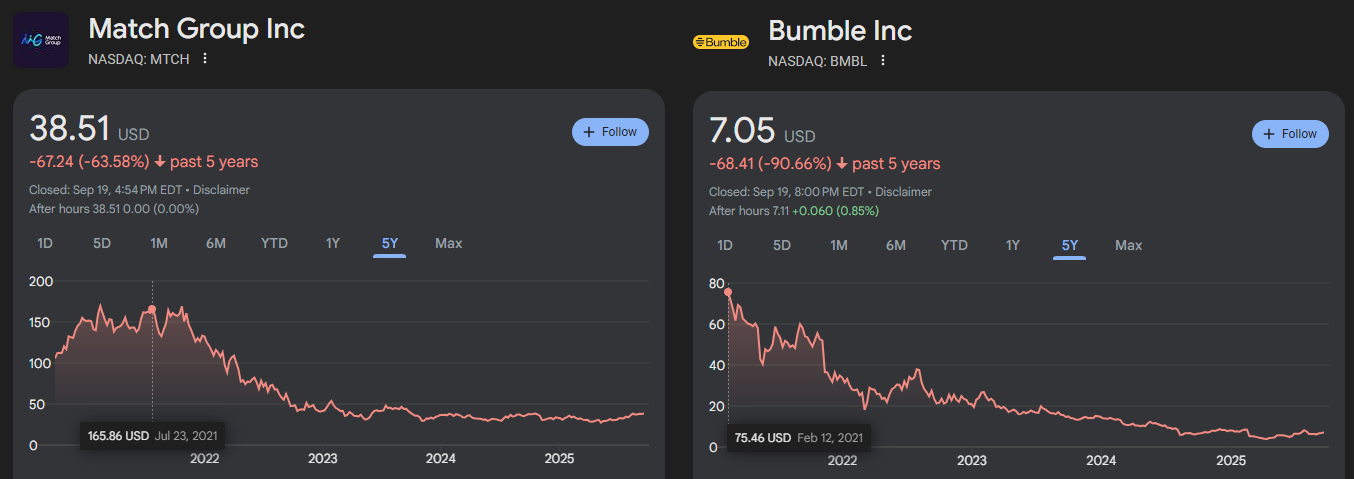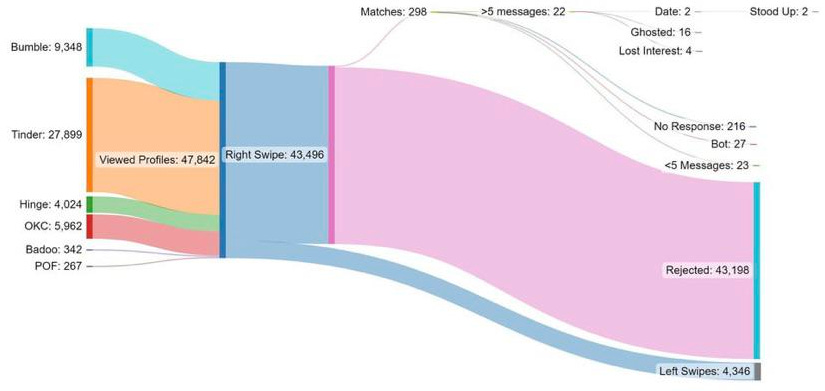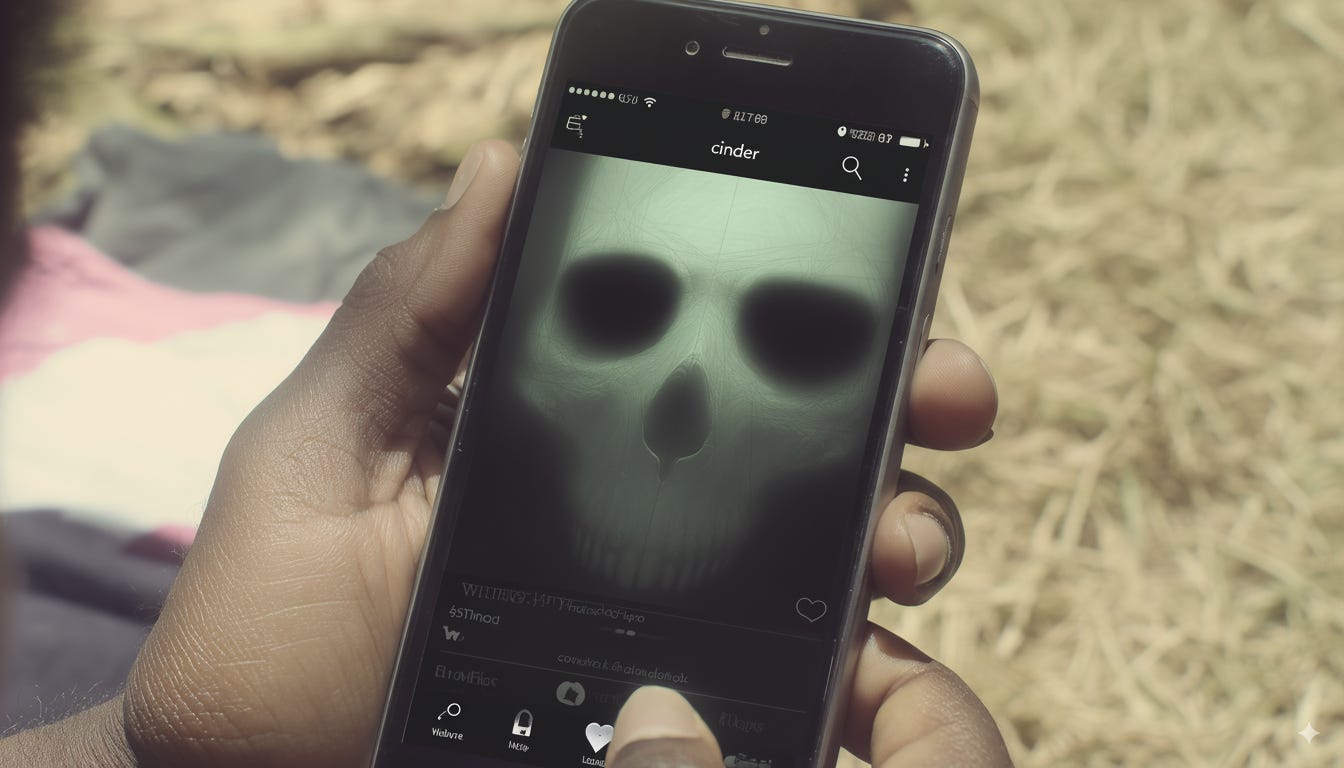Dating Apps Are Dead. And We Have Killed Them
The users are the product, and the product is turning to shit
Dating apps launched a generation ago with a beautiful promise: to bring the ease and abundance of the internet to the world of romance. Instead of blind circumstance, the apps promised comprehensive filters and sophisticated matchmaking algorithms. Instead of the awkwardness of approaching strangers, they promised safety and convenience. Most of all, they promised choice: thousands and thousands of potential matches at your fingertips.
In 2025, that promise is dead. Instead of safety and convenience, people complain about harassment, ghosting, and pervasive lying. Instead of abundance — endless frustration. The biggest app by far is Tinder, an infinite scroll of shallowness with no advanced features beyond “boosts” and “priority likes” that exploit slightly desperate men for money. Net user satisfaction is barely above water and falling fast. Though it’s hard to find recent data, app usage may have peaked during COVID and is falling, especially among young people.
If you don’t trust me, ask the shareholders:

Everyone asks, why can’t we just go back? Why can’t we just recreate 2014 OkCupid with the smart sorting and long thoughtful profiles and question-based match percentage calculator?
The reason is that these features never mattered in themselves. The match percentage was easily hackable, and most users never wrote or read very thoughtfully either. OkCupid worked because the promise of data-driven matchmaking attracted 2 million active users to the app in 2014. These users were disproportionately urban and educated, and enough of them were diligent about messaging, optimistic about meeting up, and serious about relationships. Terese and I both joined the app in 2014 when we moved to NYC.
And then in 2015, we met each other and left the app. Instead of acquiring new users to replace us, OkCupid spent the rest of the decade participating in political boycotts and adding Tumblr sexualities to its menu. They replaced the OkCupid data science blog with astrology and the relationship questions with this:

The proximate reasons for these changes is that OkCupid replaced a lot of its early employees, who were data-obsessed nerds, with younger hires who were too online and way too woke. But the app didn’t die because its staff spent 5 years trying to make sapiosexual a thing. They wasted their time because they had no way to find 2 million more users like Terese and me. And without people you’d want to date, what’s the point of a dating app?
There are still some active users on OkCupid wandering the ruins like hungry ghosts. Many of them have been there since 2014, if not before. Surely the 43,497th swipe is the lucky one, they think.
Fatal Economics
The only thing that matters in a dating app is the quality of its userbase. Unfortunately, there is no way for an app to grow or make money sustainably without the quality of its userbase decaying. This dynamic wasn’t obvious in the early 2010s because enough users who were new to apps were joining. Around 2020, the apps reached complete saturation with 50%-60% of single Americans having used them, almost touching the penetration of social media (73%). Without naive users to replenish the pool, the apps were forced to look down at their long run sustainability strategy and saw this:
When I talk about user quality, I don’t mean attractiveness. How hot you are determines your own relative success on apps but not the total number of people who will find a partner on them. People like to swipe on hot people for entertainment, but everyone mostly ends up dating their looksmatch.
What matters for apps actually matchmaking couples is users’ skill at finding and meeting well-matched partners. A quality user pays for premium, has an honest profile, selects for compatibility, writes thoughtful messages, and shows up to the date with a good mood and an open heart. A shit user swipes brainlessly, has AI sloptext and retouched pics, can’t text, and if they actually show up to the date you wish they hadn’t. Your experience on a given app is shaped by the sex ratio and the ratio of quality to shit users.
On a given app, both ratios will, slowly but inexorably, trend downwards.
If an app is good at setting people up, its best users will match each other and leave. If an app sucks at matchmaking, its best users will leave to date elsewhere. If it’s cheap and does no marketing, it will attract lazy users who sign up for every app hoping that sheer numbers will make up for being utterly adrift. If the app grows fast with aggressive marketing, it will attract Marl:
The first thing you need to know about Marl is that he has the attention span of a goldfish on acid. Once Marl opens your app, you have about 1.3 seconds to catch his attention with a shiny image or triggering headline, otherwise he’ll swipe back to TikTok and never open your app again. Marl’s tolerance for user interface complexity is zero. As far as you can tell he only has one working thumb, and the only thing that thumb can do is flick upwards in a repetitive, zombielike scrolling motion.
Every social app that makes money depends on network effects and success spirals. On an individual level, positive feedback (e.g., upvotes) increases subsequent engagement and effort on the app. Collectively, the more people join an app the more and better people will want to join. That’s why no amount of jank and broken features can kill Twitter: everyone is on there because everyone who matters is on there.
For dating apps, this effect works in reverse. Individual success leads to deleting the app and never coming back, unless “success” means an endless stream of one-night stands. Every app userbase trends towards consisting of three groups only:
A tiny minority of hot men who are looking for sex only. Since the percent of profiles that a girl swipes right on is fixed at 4-5% regardless of the average attractiveness of profiles, these men will monopolize the vast majority of matches.
A minority of women who stay on the app because they see enough hot guys, and can’t get off the app because these guys aren’t looking for a serious relationship.
A majority of men who aren’t attractive enough to get a ton of matches, and aren’t skilled/motivated enough at converting rare matches to dates to find a girlfriend.
One outcome of this distribution is that everyone in groups 2 and 3, the vast majority of users, end up trying to chat with someone who has 10x as many choices1. It’s a dispiriting and humiliating exercise. Some tenacious men and savvy women will power through and meet each other, but the on-app experience makes most people want to leave or downgrade their usage to a few minutes of drunk swiping once a month — just enough for the app to count them as an “active user” on investor calls. Without replenishment, the “active userbase” trends towards consisting of dejected men willing to pay to look at tits and fantasize that the next mindless swipe will get them laid.
Disempowerment
This sounds like bad news for VCs, but what about you? If the average user is so terrible, wouldn’t you stand out on the apps just by being normal?
This works up to point in the app death spiral. In 2015, most messages women received in their OkCupid inbox were “how aer u” but there were enough genuine attempts at connection. Most profiles were boring and poorly written, but at least they were written by the user and not by ChatGPT. It was worth people’s time to read profiles and messages and to put some effort into picking out nice spots.
As the userbase deteriorates, everyone gets more discouraged about engaging in good faith until they eventually give up. When I jumped back on OkCupid and Hinge briefly in 2018, most responses I got from women were “:)” or “haha” or questions about things that were literally written in the first paragraph of my profile. It was clear that no one was bothering to read a single word, girls were just swiping on the first picture and then toggling through chats with 20 guys at once.
When I realized this was happening, I jumped to suggesting an in-person date as fast as possible, even after just 2-3 messages back and forth. I went on few exasperating dates with women I had little in common with, then I gave up. Everyone else has been slowly migrating from apps that encouraged differentiating yourself with text to one where users only ever see and interact with static photos, one at a time.
And that’s the real problem with dating apps. If good matches are rare, you need a lot of selection power to pick them apart from the chaff. If you’re one of good ones, you need a way to signal that to potential matches. The apps give you no tools for doing that, only photos and an algorithm designed to keep you engaged forever on the scroll.
You’re looking for someone who gets you, who needs what only you can provide and delights in giving you what you truly desire. Or perhaps you’re just looking for someone who’ll show up to the date on time, have a fun and responsive conversation, perhaps kiss you at the end of it, and not assault, harass, or post screenshots of your texts to some online forum. These people are sometimes on the apps and you can stumble on them, but you have almost no control over this.
Your outcomes depend a lot on which stage of a death spiral an app is on. If a new app launches and has your female friends and peers excited to sign up, it might have a few years’ run. Any app that targets a pre-selected audience or pre-existing community (like cuties! does for TPOT), will be better than a mass-market app. But I don’t see how dating apps as a whole get better at matchmaking this side of the singularity. And if you have what it takes to find good matches on apps, you almost certainly can do great off them.
Outside the apps, you can commit to your goals and develop your unique self, naturally attracting people who gravitate to it. You can develop a dozen skills that make you better at flirting, from observing people to inhabiting your body fully. You can deepen your friend circles, learning the important qualities of people and developing a natural connection without the pop quiz of a date.
Outside the apps, you date in the context of your life, as full person, and rely on social reputation to prove yourself and avoid bad actors. On the apps, you’re decontextualized, depersonalized, and all alone. You have no avenue for agency and no way to apply selection. All you can do is post a good photo and sit there swiping and hoping until hope leaves and only the scroll remains.
We killed the apps, now bury them
When people complain about dating, they often just complain about dating on apps. And when people complain about dating apps, they often complain about the product. But the fault, dear Brutus, is not in our apps, but in ourselves. We are the product, and the apps are not a market fit for it.
Dating apps could be good, for a while, when everyone was excited about their novelty and promise. But once it became common knowledge that dating apps suck, it became impossible to make a dating app that doesn’t suck. Good users don’t want to go on a dating forum that sucks, and if they do they leave quickly because they find each other or go date where they can express themselves and select for great partners. Everyone who’s good on the apps would be good at dating elsewhere, while everyone who’s bad at dating stays on the apps because they can’t think of anything better.
You’re going to keep seeing ads for dating apps, more and more bizarre ones. It costs nothing to clone Tinder and add a gimmick. They can make a bit of money mostly as an entertainment product, scratching a spot between users’ idle fantasies and quiet desperation. But they’re not going to make dating better for you. You have to go do that by yourself.
The one exception to this are antimimetic women in good dating markets who spend their limited likes on men they are well matched with as opposed to the men desired by everyone else. These women can get good returns to putting more effort into messaging and selecting, especially if they can tolerate the occasional bad date with someone who slips past their filters.






I've had two stints on the apps, 2011-2014 and 2024-2025 and they worked as well recently as they did back in the day. Notwithstanding all the problems, which are real, I don't think dating apps will lose their relevance; there's nothing else nearly as effective for what they do, which is aggregate the largest number of ~available people. Quantity has a quality all its own.
I paid 25k to make my own dating app that would solve most of the problems on apps today. Unfortunately the developers scammed me and never sent over the code. But the concept was this, one match at a time, 48 hours to plan a date, and all premium features from other apps but for free. It would’ve been called Pebble which is what penguins give eachother before they get married and the logo was two blue penguins making heart with their heads.